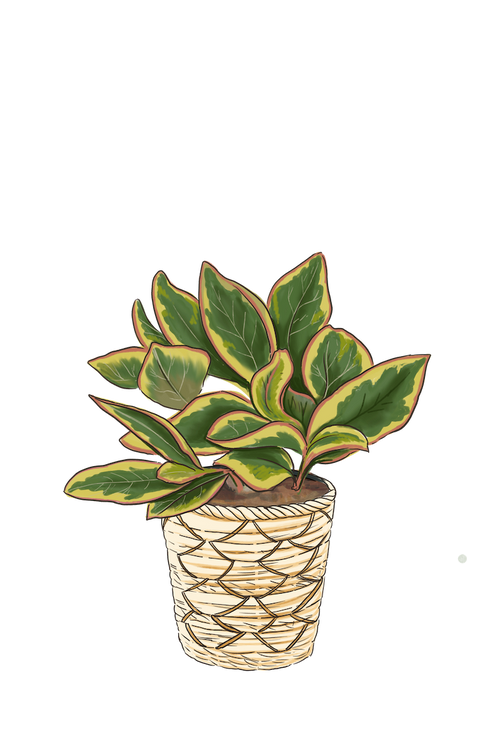Peperomia Care Guide

-
Light : Medium
Enjoys medium to bright indirect light.
-
Water : Low
Be sure to water when you receive them. Allow soil to dry between watering.
-
Humidity : Medium
Enjoys some extra humidity. Spritz occasionally.
-
Temp : 60℉ - 75℉
Keep this plant in rooms where the temperature is a comfortable 60°F-75°F and avoid cold drafts or air vents below 55°F. They thrive in warmer and humid temperatures with plenty of humidity.
-
Zone : 10|11|12
Outside: Keep in full shade on a patio out of direct sunlight to prevent leaf burn where nights are above 55°F.
-
Fertilizer : Seasonally
This plant has a small root system so too much fertilizer will burn the plant. You can fertilize three times a year in the spring, summer and fall. Apply at half-strength a balanced, liquid fertilizer especially formulated for indoor plants during the growing season and let them rest in the winter.
-
Repotting : 2 Years
When receiving the Baby Rubber Plant, do not repot immediately but wait at least 6-12 months or if the roots are beginning to get crowded and growing through the drainage holes.
Repot in the spring, using a 2 inches bigger pot to keep the roots drier. (Too big of a planter could cause the soil to dry slower.)
Place a piece of screening at the bottom of the container over the drainage hole to secure the soil and allow to drain. Use a well-draining indoor potting mix with perlite to help with drainage.
Water your plant in the old pot before transferring over and let sit an hour.
Add soil to the bottom to elevate the root ball. Lift the plant and release the roots against the existing planter. Use a clean knife or garden trowel to wedge between the pot and the soil to loosen.
Inspect the root ball. Notice if there are any dead or rotting roots and trim off with sterile pruners. If the plant is rootbound, cut through the roots to alleviate continued encircling.
Ensure the plant is sitting about 1 inch below the edge of the pot to avoid water spillage. Add more soil and backfill around the sides by tamping down. Fill up to the soil line but not over.
Water thoroughly, leaving the soil damp but not soggy. If settling occurs, add more soil.
Water well to dampen the soil and let drain.
-
Cleaning : Monthly
When watering your Rubber Tree plant, it is an excellent time to trim off any browning, yellowing, or discolored leaves. When pruning, use clean, sharp pruners. Cut above a node or where the leaves emerge on the side of the stem. Branching will occur and encourage a bushier and fuller plant. Use these cuttings to propagate. Remove any debris from the soil and replenish if needed.
To clean debris and dust off the leaves:
Place the Rubber Tree plant in a shower or tub.
Fill a watering can with a shower spout with filtered, bottled, or water free of chlorine and fluoride.
Shower the leaves, so each one is clear of dust and dirt.
Let the water drain and replace your plant in the decorative container.
-
Propagation : Cuttings
To propagate this plant during the growing season:
Take a 4-6 inch stem cutting in the early spring.
Use a knife or sharp pruners, cut below a node where there are at least three leaves.
Remove the bottom leaves to expose the node.
Place the stem in a glass jar and fill them with filtered water and watch the roots grow! Replace and freshen the water each week.
After the roots are six weeks old, add the cuttings to moistened potting soil, continue to water, and give it the bright, indirect lighting requirements.
To propagate this plant by division during the growing season:
Water your plant the night before dividing.
Inspect your plant for overcrowding. If they are root-bound in the pot, loosen the dirt around the root clump and brush away the soil.
Begin to tease and pull apart the mass of roots.
Divide each clump into their pot, measuring 2 inches wider than the root mass and deep enough for their roots to grow.
Plant in well-draining potting mix amended with rooting hormone. Adding a rooting hormone during planting will help diminish the symptoms of transplant shock.
Place the plant at the same level as the previous pot adding soil at the bottom. Water the soil and add more if settling occurs. Set them in medium, indirect sunlight.
Check the moisture and humidity each day and add misting to keep the soil moist while the roots establish. After 6-8 weeks, roots will begin to develop. You can tug onto the stem to ensure the roots are anchoring well.
Keep the air humid around them with a pebble tray and misting.
Some die off of stems may occur from transplant shock. If this happens, cut the branches away and continue to hydrate, and keep the humidity level at a medium level while they recover. Adding a rooting hormone during planting will help diminish the symptoms of transplant shock.













